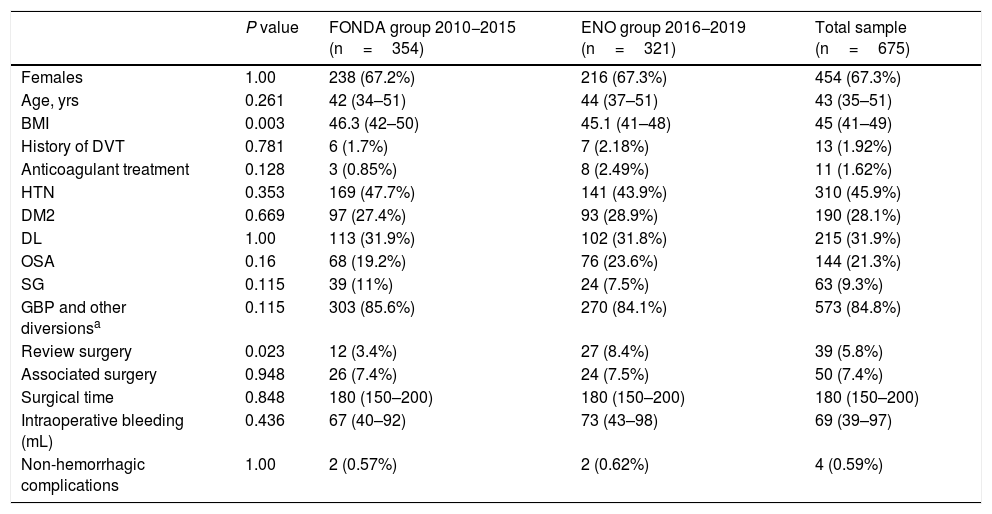To determine the thrombotic and hemorrhagic risk in bariatric surgery with multimodal rehabilitation programs, comparing two guidelines of pharmacological prophylaxis recommended in the Guide to the Spanish Society for Obesity Surgery and the Obesity Section of the AEC.
MethodsCohorts retrospective study from January-2010 to December-2019. Cases of vertical gastrectomy or gastric bypass were recorded, systematically applying multimodal rehabilitation protocols. Two reduced chemoprophylaxis regimens were analyzed, starting after surgery and maintained for 10 days; one with fondaparinux (Arixtra®) at a fixed dose of 2.5mg/day and the other with enoxaparin (Clexane®) with a single daily dose adjusted to BMI: 40mg/day for BMI of 35–40 and 60mg/day for BMI 40–60.
Results675 patients were included; 354 with Fondaparinux-Arixtra® during the period 2010−2015 and 321 with Enoxaparin-Clexane® during the period 2016−2019. There were no cases of DVT or clinical PE. However, the incidence of hemorrhage requiring reoperation, transfusion, or a decrease of more than 3g/dL hemoglobin was 4.7%, with no difference between groups. Mortality was nil. The average stay was 2.8 days and the outpatient follow-up was 100% during the first 6 months and 95% at 12 months.
ConclusionsThe combination of multimodal rehabilitation programs and mechanical and pharmacological thromboprophylaxis by experienced teams, reduces the risk of thromboembolic events and could justify reduced chemoprophylaxis regimens to decrease the risk of postoperative bleeding.
Determinar el riesgo trombótico y hemorrágico en la cirugía bariatrica con programas de rehabilitación multimodal, comparando dos pautas de profilaxis farmacológica recomendadas en la Guía de la Sociedad Española de Cirugía de Obesidad y la Sección de Obesidad de la AEC.
MétodosEstudio retrospectivo de cohortes desde enero-2010 a diciembre-2019. Se registraron los casos de gastrectomía vertical o Bypass gástrico, aplicando sistemáticamente protocolos de rehabilitación multimodal. Se analizaron dos pautas reducidas de quimioprofilaxis, de inicio tras la cirugía y mantenida durante 10 días; uno con fondaparinux (Arixtra®) a dosis fija de 2,5mg/día y otro con enoxaparina (Clexane®) con dosis única diaria ajustada al IMC: 40mg/día para IMC de 35-40 y 60mg/día para IMC de 40-60.
ResultadosSe incluyeron 675 pacientes; 354 con Fondaparinux-Arixtra® durante el periodo 2010-2015 y 321 con Enoxaparina-Clexane® durante el periodo 2016-2019. No hubo ningún caso de TVP o TEP clínico. No obstante, la incidencia de hemorragia con necesidad de una reoperación, trasfusión o con un descenso de más de 3g/dL de hemoglobina fue del 4,7%, sin diferencias entre los grupos. La mortalidad fue nula. La estancia media fue de 2,8 días y el seguimiento ambulatorio fue del 100% durante los primeros 6 meses y del 95% a los 12 meses.
ConclusionesLa combinación de programas de rehabilitación multimodal y tromboprofilaxis mecánica y farmacológica por equipos experimentados, reduce el riesgo de eventos tromboembólicos y podría justificar las pautas reducidas de quimioprofilaxis para disminuir el riesgo de una hemorragia postoperatoria.











